
App download estimates explained: How to interpret app download data
App download estimates are a critical metric for marketers and developers aiming to grow their apps. Powered by app store signals, machine learning, and historical trends, these projections offer a clear, data-driven view of market performance. In this article, we’ll explore why app download estimates matter, what influences them, and how AppTweak’s model analyzes them.
With over a decade of experience in app store marketing, AppTweak has built one of the industry’s most robust datasets, drawing on hundreds of millions of aggregated, privacy-compliant data points across countries and categories. In this article, our data science team shares how we estimate app downloads and why you can confidently rely on AppTweak’s intelligence to support your app’s growth strategy.
Key takeaways
- App download estimates are projected figures which indicate how many times an app has been installed.
- These estimates are crucial for benchmarking app performance, understanding category competitiveness, and measuring the impact of ASO and UA efforts.
- Category ranking and seasonality are two of the most influential factors that impact app download volume.
- App store intelligence platforms like AppTweak use deep learning model trained to deliver highly accurate daily download estimates.
- Marketers use this data to evaluate campaign impact, monitor competitors, identify growth opportunities, and make more confident, data-driven decisions.
What are app download estimates?
App download estimates are projected figures that show how many times a mobile app has been downloaded from app stores like Google Play or the App Store. As these app stores do not publicly share exact download numbers for most apps, most app marketers utilize third-party tools to generate these estimates using data such as app store rankings, historical trends, and machine learning models.
Why are app download estimates important?
App download estimates play a vital role in mobile marketing, competitive analysis, and investment decisions. App marketers utilize app download estimates to understand their app’s performance and compare it against competitors. Here’s why app download estimates matter.
1. Track market trends and benchmark
Estimated app download data offers visibility into how competing apps are doing across categories, countries, and platforms.
By tracking these figures over time you can:
- Identify fast-growing apps or new and disruptive entrants.
- Benchmark your performance against category leaders.
- Compare the competitiveness of different countries for your app category.
- Detect market trends early to adapt your strategy.
2. Make smarter ASO and paid UA decisions
By understanding the estimated downloads of your competitors, you can better improve your app store optimization (ASO) strategy and user acquisition strategy.
For example, by integrating your mobile measurement partner (MMP) with AppTweak, you can see download estimate data combined with seasonality and ranking trends for a comprehensive overview of the app market. Additionally, AppTweak allows you to perform app store keyword research so you can prioritize keywords based on search volume, competition, chance score, and keyword relevancy.
3. Determine investments
From investors, publishers, to business teams, many rely on app download estimates to help them evaluate acquisition targets, sizing up market share, and assessing the growth potential of apps.
Expert Tip
Don’t just track downloads—analyze revenue trends too. Revenue estimates reveal how well apps convert installs into paying users, offering a clearer view of true market performance and profitability. You can compare both metrics side by side in AppTweak’s Market Intelligence to identify which apps and markets deliver the highest return potential.What factors influence app downloads?
App downloads are influenced by multiple factors grouped by visibility, market context, and timing. Understanding these factors helps app marketers identify why certain apps surge in popularity while others struggle to gain traction. Below are the key elements that shape download volume across app stores.
App store visibility
An app’s visibility in the app store is one of the most powerful drivers of downloads. The higher your app appears in search results, top charts, or category rankings, the more exposure it gains.
This visibility is primarily determined by App Store Optimization (ASO)—the process of improving metadata (title, subtitle, keywords, description) and visual assets (icons, screenshots, videos) to increase discoverability.
Apps that consistently refine their ASO strategy tend to maintain steady growth, as they align better with user search intent and store algorithms.
Read about the best ASO tools to help you win the app stores algorithms.
Reviews and ratings
Positive reviews and high star ratings strongly influence both visibility and conversion. App stores often reward apps with higher ratings by ranking them more prominently, while users are more likely to download apps that appear trustworthy and well-rated. Responding to reviews and addressing user feedback also signals to the store’s algorithm that the app is active and user-focused.
Learn how to best manage app store reviews.
Updates and freshness
Frequent updates can improve an app’s ranking and attract new users by showing ongoing maintenance and feature improvements. Store algorithms tend to favor apps that are regularly updated, as it indicates reliability and responsiveness to user needs. Highlighting new features in your update notes can also re-engage existing users and drive re-downloads.
Region
Download performance varies greatly by region due to differences in device usage, connectivity, cultural preferences, and economic factors. For example, apps in the gaming or finance categories might perform well in markets like the United States, Japan, or South Korea, while lifestyle or utility apps might see stronger traction in emerging markets such as India or Brazil. Localizing app metadata, creatives, and pricing is essential to maximize downloads in each market.
Category
Not all categories compete on the same scale. Games, social, and entertainment apps typically generate higher download volumes, while niche or B2B apps may have smaller but more targeted audiences. Competition also differs between categories—ranking in the top 10 of a saturated category like “Games” can require exponentially more downloads than achieving the same rank in “Productivity” or “Tools.” Understanding your category’s competitiveness helps set realistic performance goals.
Uncover download and revenue insights for free with Market Intelligence
Want to explore these country-level insights yourself? AppTweak’s new Market Intelligence Starter plan lets you access free download and revenue estimates for any app or publisher across 100+ countries. It’s a quick way to uncover which apps or categories drive growth in your market.
The Market Intelligence Starter plan includes lifetime totals and last-month estimates for both the App Store and Google Play, along with access to essential views like Top Charts and Publisher Overview. It’s designed to help you explore reliable market data and validate opportunities.
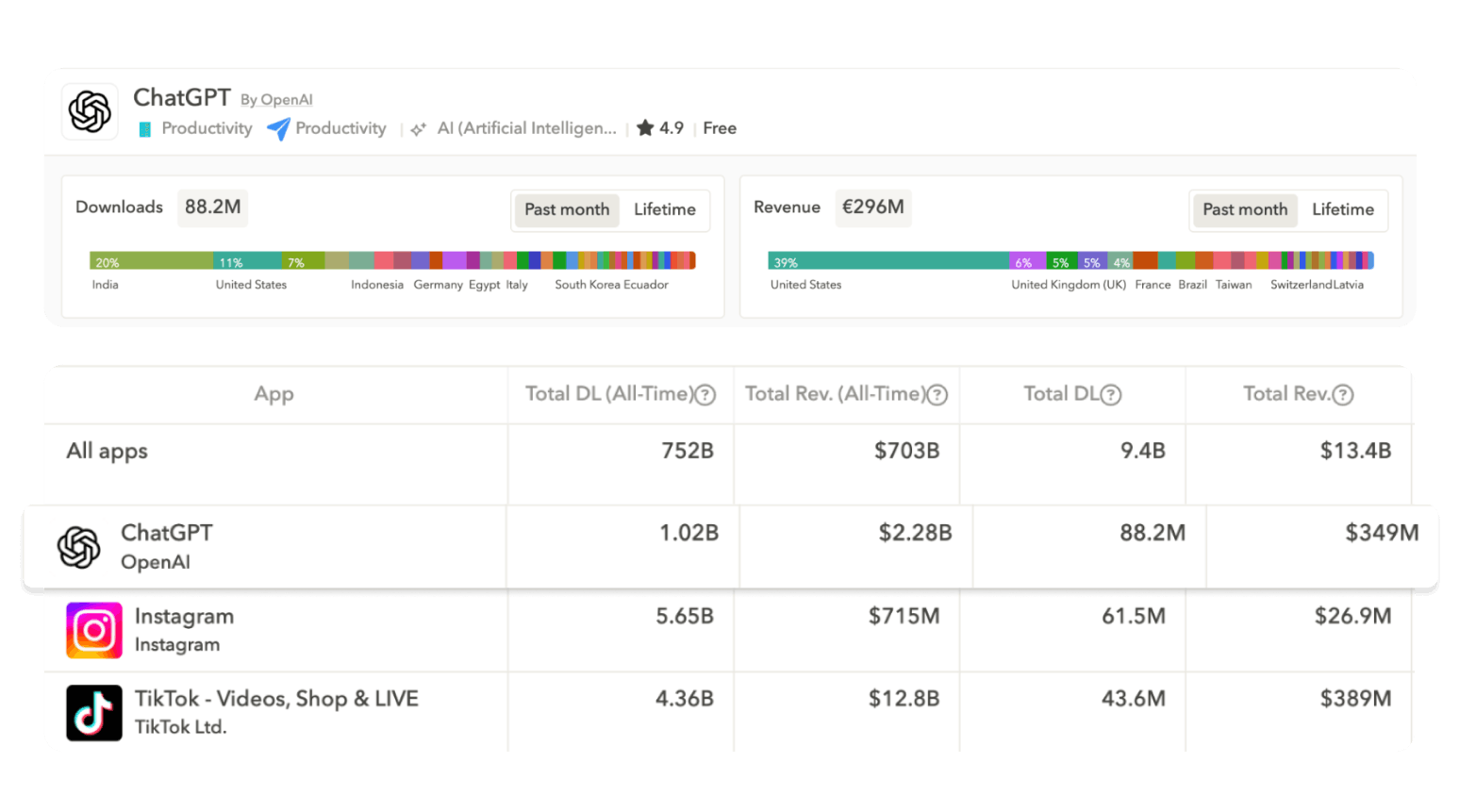
Read more about our Starter plan and the next-gen updates to Market Intelligence.
Seasonality
Another factor that significantly influences app download estimates is seasonality. While this differs among categories and markets, seasonal events can have a huge impact on app downloads. Take a look at the following examples.
Sports apps and seasonality
Sports apps typically see an increase in downloads around popular sports events in different countries. For example, in the U.S. football season starts in the month of September, during which we observe an increase in downloads of up to 51%. In contrast, Indian sports apps see peaks of up to 50% in app downloads during the Indian Premier League in April.
 Comparing the yearly seasonality of the Sports category on Google Play in the United States and India within AppTweak’s Market Intelligence
Comparing the yearly seasonality of the Sports category on Google Play in the United States and India within AppTweak’s Market Intelligence
Travel apps and seasonality
As you can expect, app downloads for the travel category differ from one hemisphere to another. In the U.S. and the U.K., travel apps enjoy greater downloads during their summer months of June through September while those in Brazil see a similar increase during their summer between October and January.

Games vs. business apps seasonality
Seasonality can be inspected not just on a monthly basis, but by looking at the app download data by week to see if there are trends like weekdays versus weekends. Unsurprisingly, mobile gaming apps tend to earn more downloads during the weekend than the weekday while business apps see more downloads during the week.

Sports vs. Health & Fitness apps seasonality
Other categories that see these weekly trends include sports and health & fitness apps, and quite opposite trends at that. Sports apps downloads shoot up on the weekend, when most sporting events occur. Health & fitness apps, on the other hand, are most often downloaded at the beginning of the week when people reset their fitness and wellness goals.

More on our market seasonality feature
As you can see, there are several important factors that impact your app downloads. This is why it’s important to ensure you’ve access to tools that can provide you with market analysis, ASO efforts, and overall campaign strategies.
How are app download estimates calculated?
As most app stores don’t disclose the exact number of app downloads, app download estimates are calculated using a combination of app store signals, historical trends, and proprietary algorithms belonging to third-party app intelligence platforms like AppTweak.
Types of data used
To estimate the number of downloads an app receives, app store intelligence platforms combine the following data sources.
Public metadata: This data can include an app’s ranking on that store, the number of reviews, update frequency, category relevancy, and other visible signals.
Panel data (if available): Some tools may use opt-in panel data or integrate with a mobile measurement partner (MMP) to access anonymized install metrics. Then, this data is used to train and validate estimation models.
Proprietary machine learning algorithms: These algorithms serve to analyze patterns across hundreds of millions of data points, adjusting for category, country, seasonality and more. They then make fairly precise predictions about how many an app likely receives on a daily basis.
Common estimation models
Different app intelligence platforms utilize variations of the following modeling techniques.
Regression models: These models analyze the relationship between app rank and known download volumes. For instance, they can uncover that apps ranked in position five tend to receive around X number of downloads per day.
Time-series modeling: This type of modeling examines historical patterns in downloads and ranks to forecast future performance. This approach is incredibly useful to capture trends over time or during seasonal events.
Behavior-based inference: Some tools refine their estimations by analyzing user behavior patterns like engagement metrics, app updates, or feature releases.
Challenges in accuracy
Although download estimates can be highly informative, several factors can impact their precision.
1. Country-level data gaps
In some regions, publicly available data is limited, making it hard to model downloads accurately for those regions.
2. Platform differentiators
Because user behavior, store ranking algorithms, and app visibility can differ significantly across app store platforms like the App Store and Google Play, impacting model consistency.
3. Sudden traffic spikes and seasonal events
Download estimates can be skewed by short-term spikes caused by UA campaigns or seasonal events. These surges are not necessarily anomalies, but they represent behavior that differs from typical download patterns. If not properly accounted for in the model, these spikes can distort estimated trends or even inflate perceived performance.
How AppTweak calculates app download estimates
To truly dive into the data science driving AppTweak’s app store marketing intelligence platform, we asked our Head of Data Science, Jonathan Frische, to explain the methodology and algorithms used by our team.
As a pioneer in the app store marketing field, it was a priority for us to use deep learning to estimate the number of downloads an app drives every day in any store and country on iPhone, iPad, and Android. Therefore, we built our proprietary deep learning model to ensure data accuracy and to build upon the app store data we’ve been collecting for over 10 years.
One of the major advantages of developing our own deep learning model that is both (1) cross-country and (2) cross-category. This means the model truly learns and understands the relationships between countries and categories, and can therefore benefit from the data of different categories in different parts of the world to estimate the overall downloads of one specific app.
What AppTweak’s model analyzes
For each device and app type, we feed our deep-learning model with the data collected from the thousands of apps connected to AppTweak. Note that we’re continually retraining this model to maintain its accuracy, ensure it adapts to market changes, and reflects the most recent anonymized user behavior and app store dynamics.
Every day for each app, we define a set of features related to:
- The app’s category rank
- The date (seasonality)
- The country
Then, we map these features to the number of daily downloads the app is driving, allowing our model to learn the most relevant relationships between the different features and their related downloads.
This technique helps us identify unique insights such as the impact of Christmas across different categories and countries, or which countries have similar levels of competitiveness in terms of downloads.

Learn more about app seasonality trends for the holiday season
Once our model has a deep understanding of these relationships, we are ready to predict the number of downloads for any app for which we don’t have data—from any category, in any country, and at any point in the past. Thanks to the many metrics we tracked during the learning process, we are confident that this model can estimate the downloads of an app with extremely high accuracy.

AppTweak’s estimates based on a large data pool
As mentioned above, our ability to provide our users with accurate download and revenue estimates is a result of the large pool of mobile app data we have captured over the years.
Our model uses the data from apps worldwide to predict estimates in each specific country. Typically, to predict the number of downloads a financial app makes in Vietnam, the model benefits not only from all the data we have access to in Vietnam but also from the data we have for any financial app in the world.
As our pool of data grows significantly over the years—since 2014—as more and more users connect their data to AppTweak, this data is fed into our algorithms which are constantly improved over time.
What factors influence app download estimate at AppTweak?
AppTweak’s deep learning model takes into account two correlative factors when calculating app download estimates: category rank and seasonality.
Factor 1: Category rank
AppTweak’s data reveals a high correlation between an app’s ranking in its category and the number of its daily downloads. Our data scientists have noted that the number of downloads an app accrues in one day typically has a direct impact on its category rank for the next several days.
For example, we looked at the app download estimates for the cryptocurrency exchange app, Binance and compared them to Binance’s ranking in the Finance category. As you can see, when downloads spiked on January 19, Binance’s category rank also increased over the next three days, peaking on January 21.
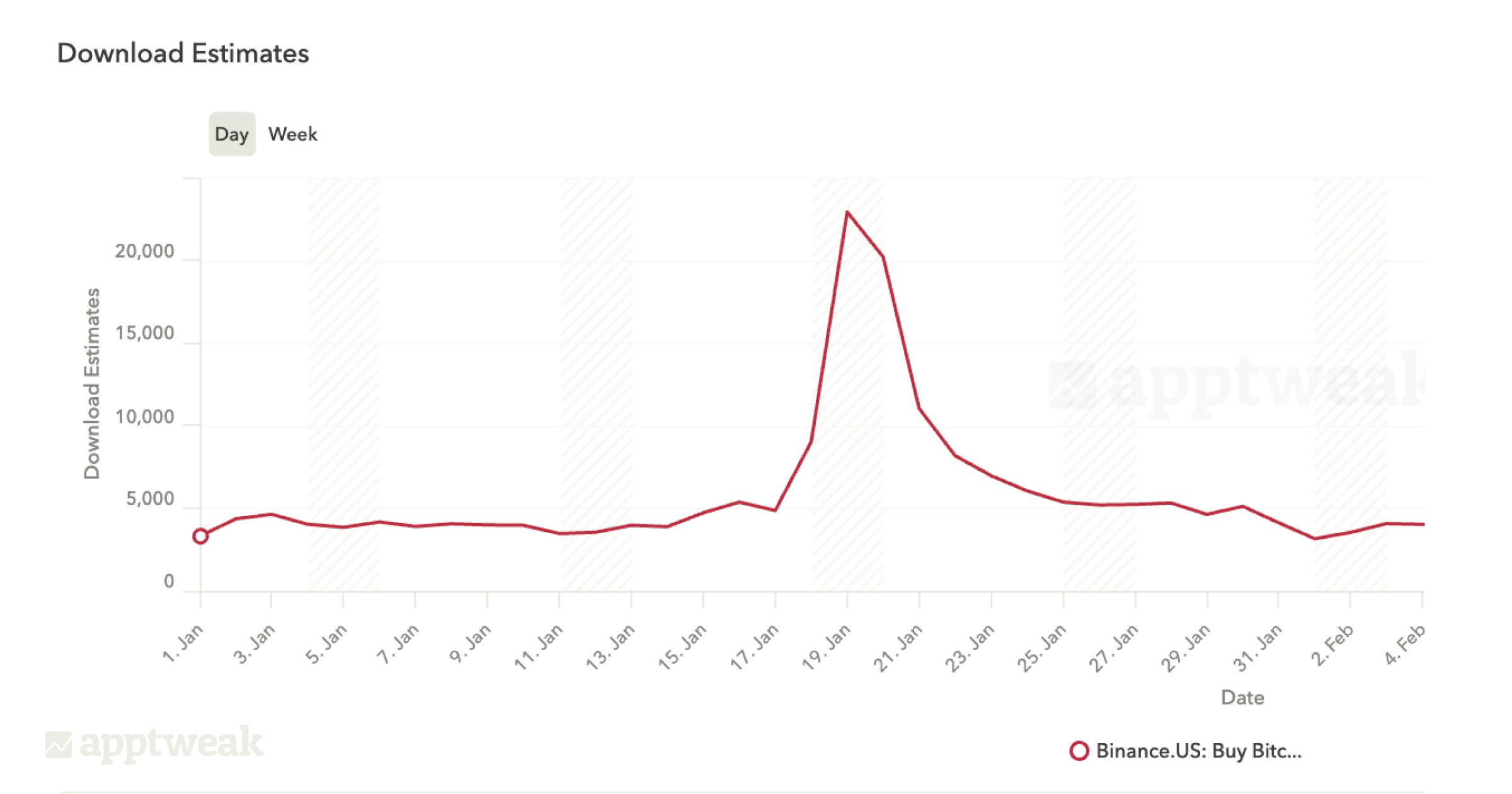
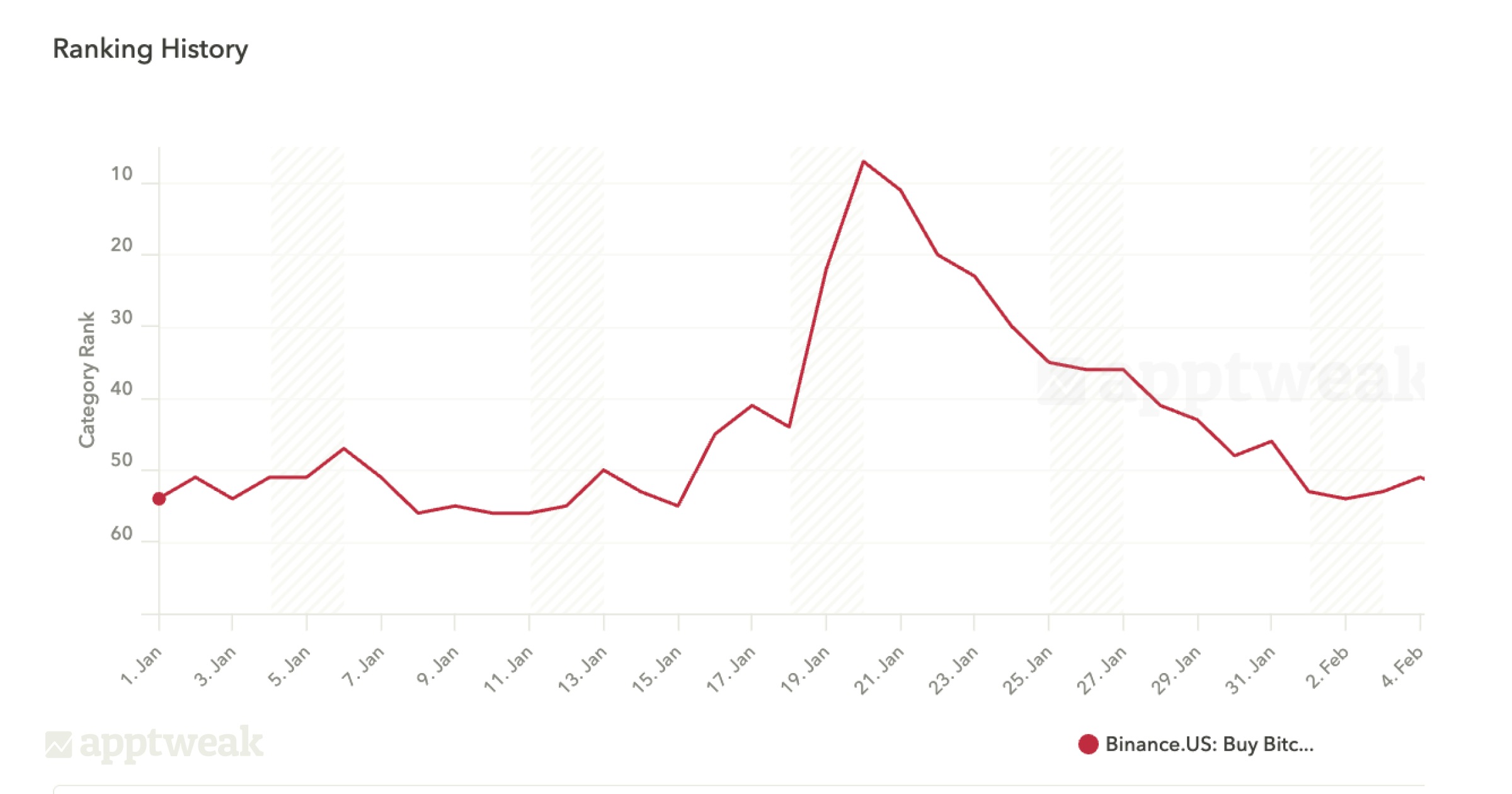
Expert Tip
Utilize AppTweak’s Downloads to Top feature to get the estimated number of downloads needed to reach the top rankings in any category or country. This helps you set more realistic growth goals and prioritize UA or ASO efforts where they’ll have the most competitive impact.Note: Competition among categories varies
Individual categories and markets each have their own level of competition. For example, the top 10 apps in the Games category tend to have a much higher number of daily downloads than the top 10 Tools apps.
Using AppTweak’s Market Intelligence, we can note a major difference between these two categories when comparing the total number of downloads and revenues over time on both the App Store and Google Play. See this comparison below.
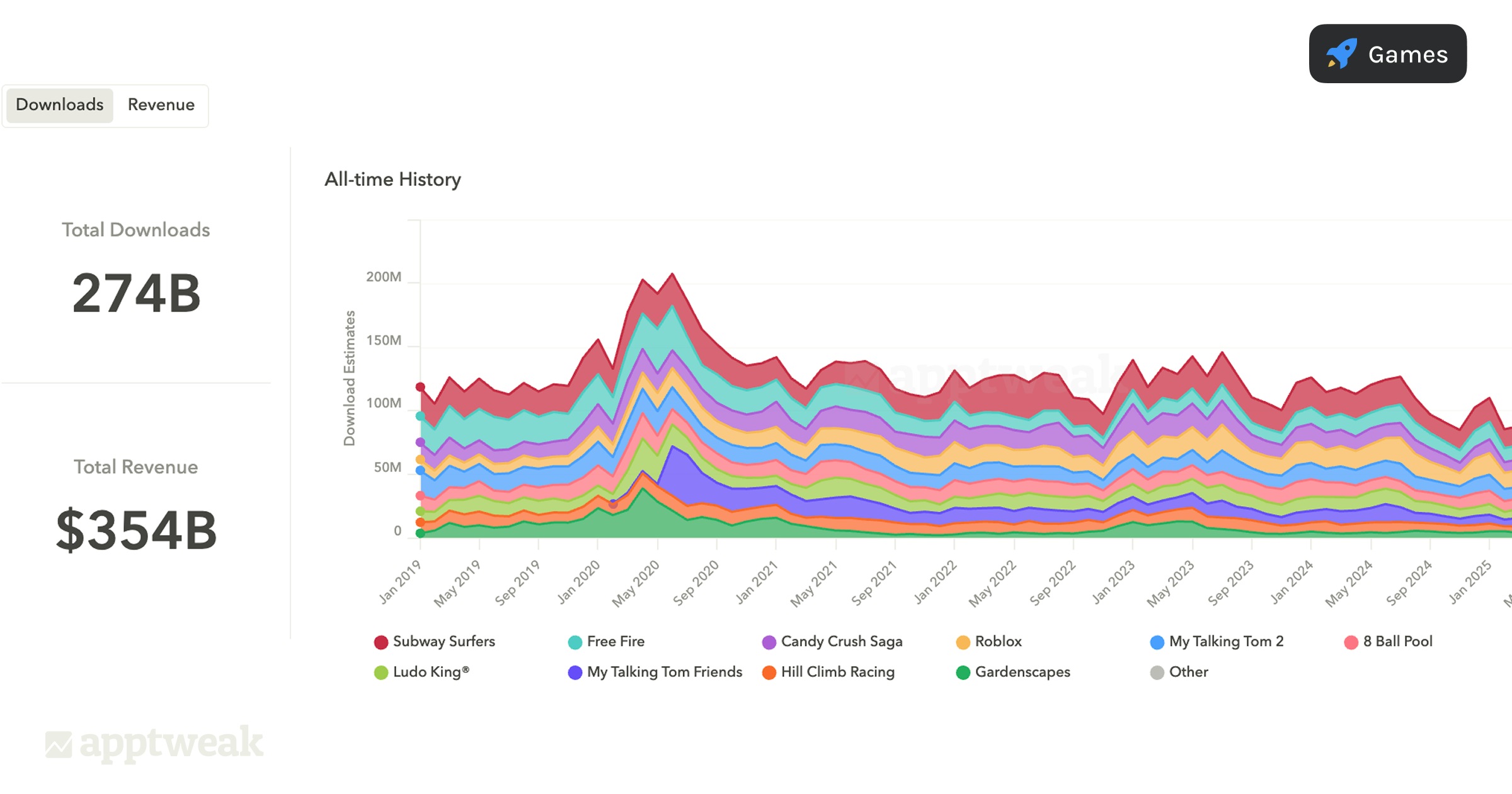
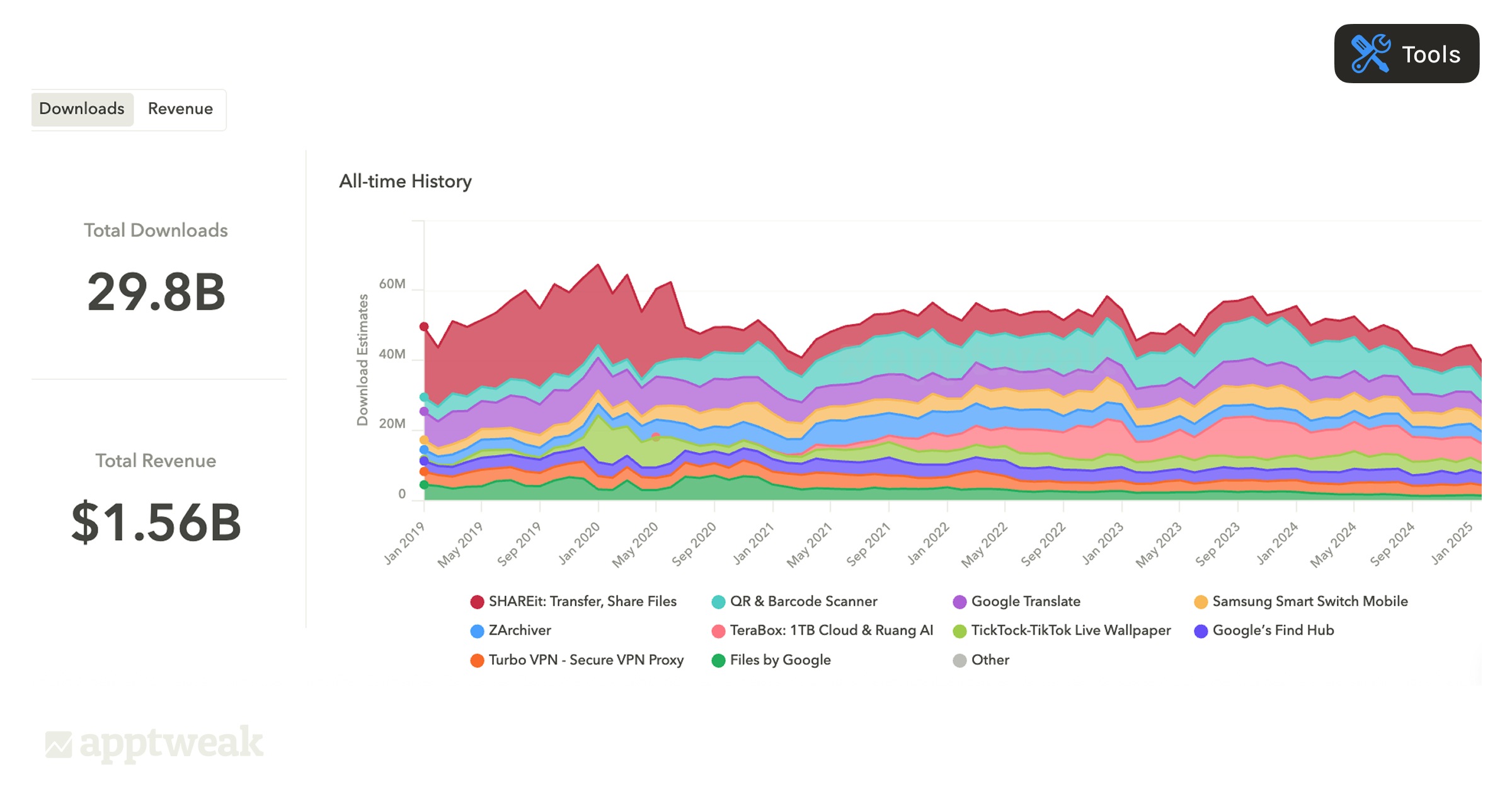
Take country competitiveness into account
It’s also important to account for the different levels of competition among countries. If we look at the U.S., for example, we’ll see that it’s the most competitive country on the App Store while India is the top country for Google Play.
So, if you’ve a gaming app, your app will require more daily downloads to rank in the top for these two countries compared to any others, as illustrated in the graphs below. To learn how many, check out our article How many downloads does your app need to reach top rankings, which explains how AppTweak’s Market Intelligence provides this intel.
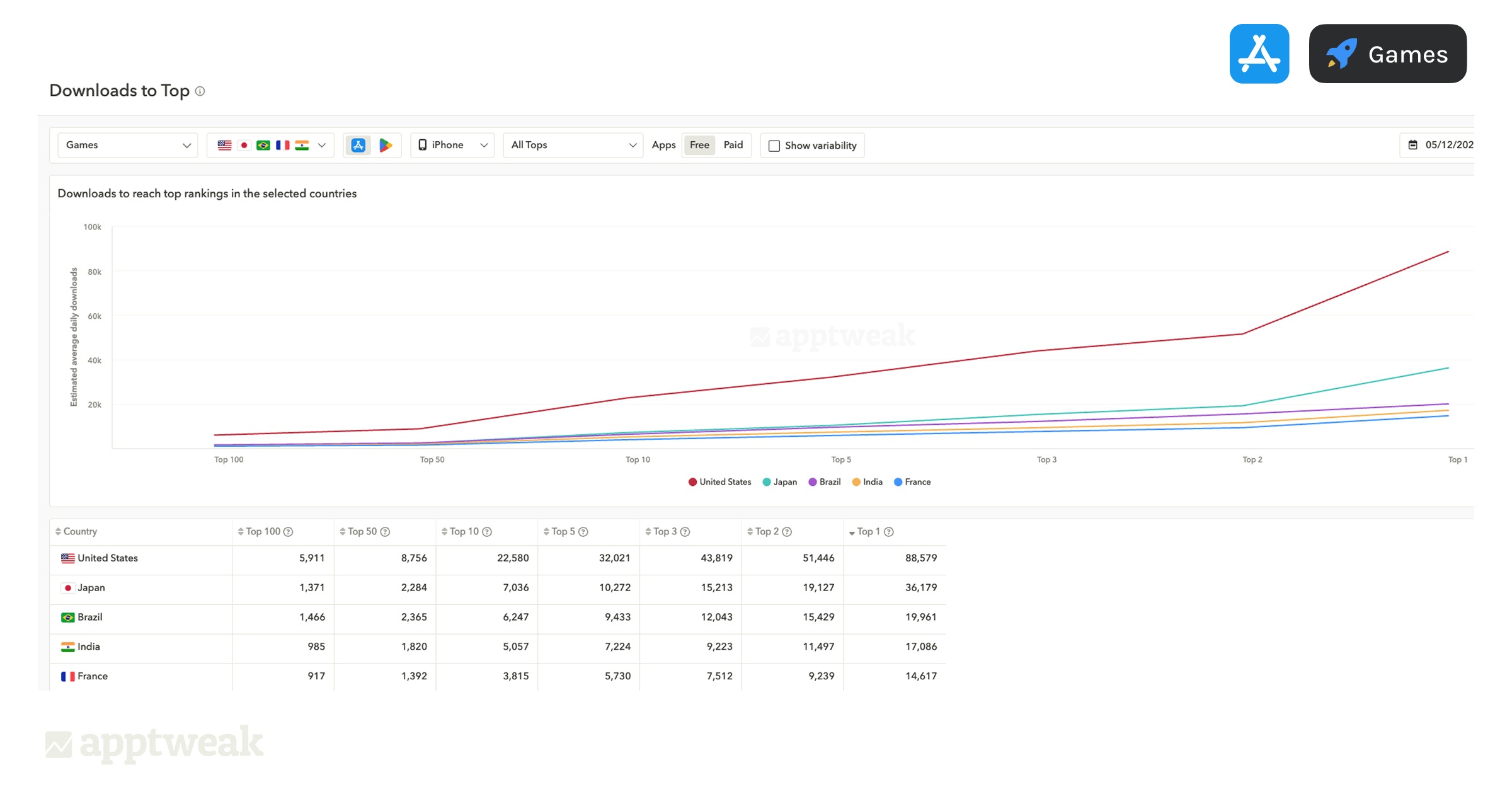
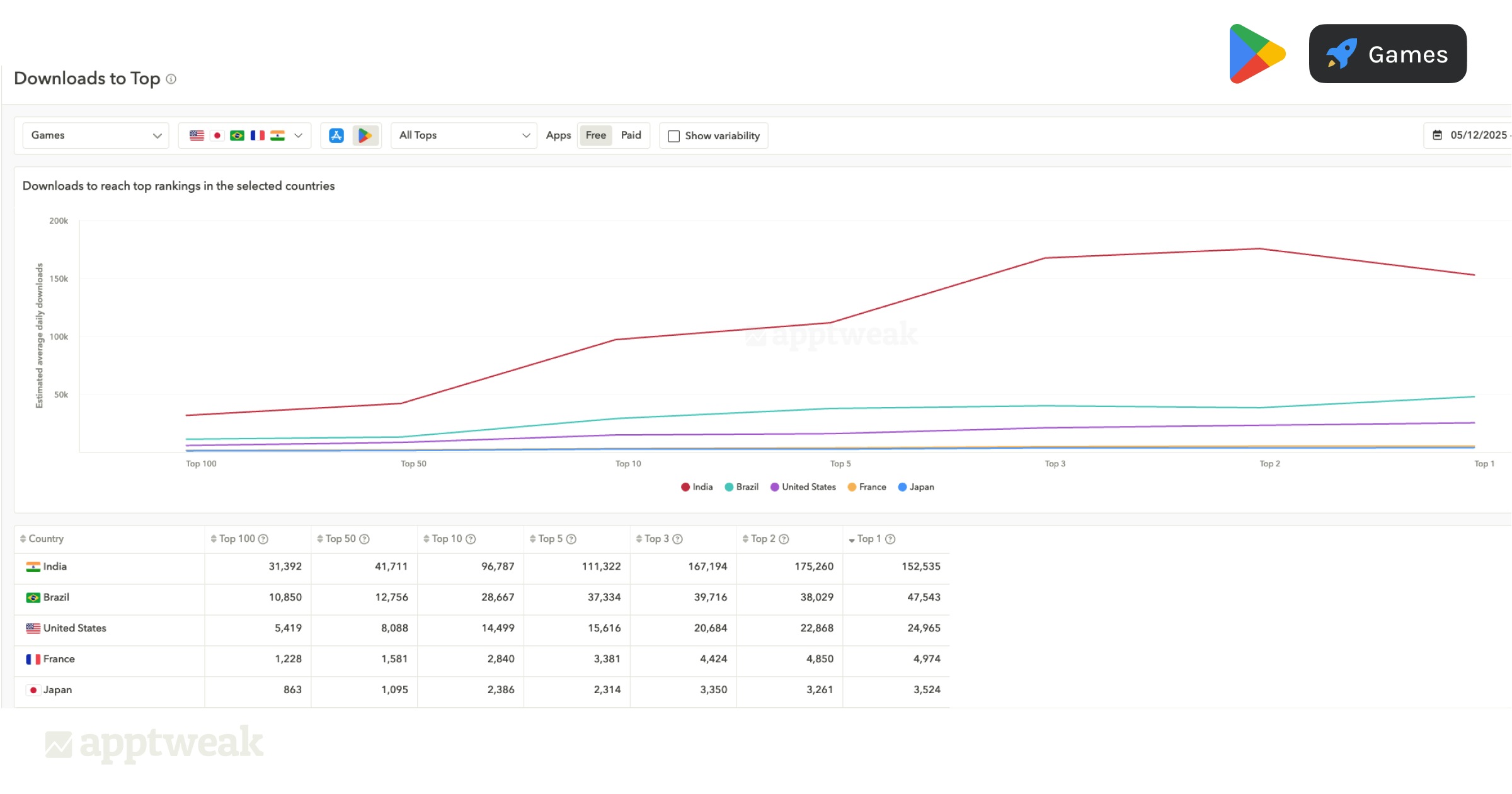
Factor 2: Seasonality
As mentioned above, seasonality is a huge factor that influences how we estimate app downloads at AppTweak. For example, we know that a shopping app ranked number one on Black Friday will have many more downloads than when they rank number one in April. Therefore, we’ve trained our model on this for all categories across the app stores.
Concrete example of how marketers use app download data
Here is a powerful example of a brand utilizing app download data to inform its app marketing strategies.
Discover and adapt to market shifts: Bitcoin.com
Marketers need to be able to determine the impact of their major campaigns or metadata or creative changes, as well as local market shifts. To do so, they can perform an incrementality analysis.
For example, we analyzed the app download data of Bitcoin.com looking at three years of historical data to create a baseline forecast of expected downloads during and after the event: the 2024 U.S. presidential election. Our extrapolation model confirmed that Donald Trump’s election to the U.S. presidency was not just a temporary spike but a true market shift.
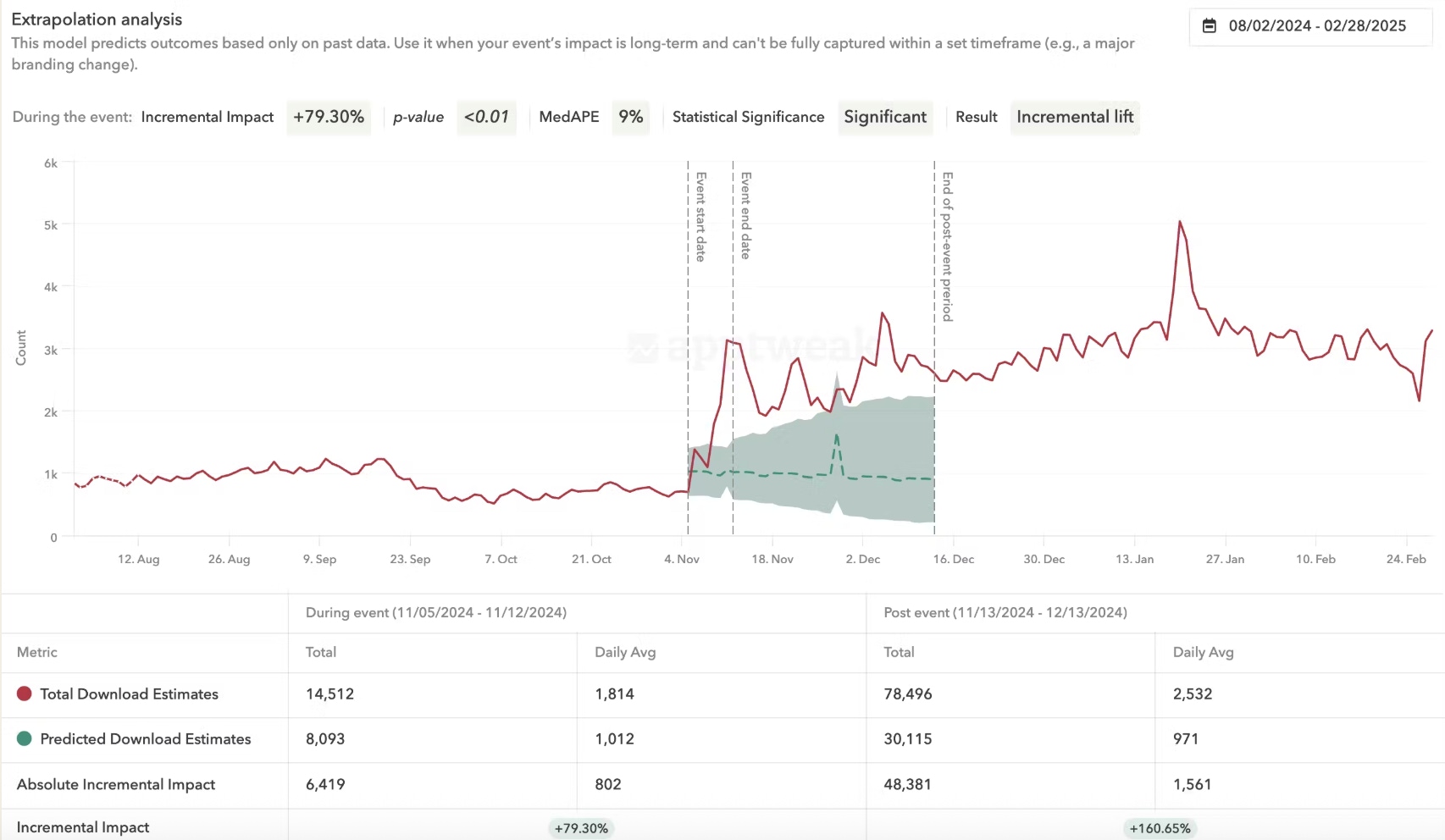
Conclusion: Make smarter decisions with app download estimates
App download estimates play a crucial role in today’s app marketing landscape. Whether you’re evaluating campaign effectiveness, benchmarking against competitors, or identifying new market opportunities, these estimates offer valuable context where real data is limited. When used correctly, they help you measure performance, validate strategic choices, and uncover where to optimize next.
To get the most value, always consider the estimation model behind the data and use it in combination with other ASO and market intelligence metrics. Check out our guide on How to build an effective ASO strategy to learn how to build a winning growth plan.
With a trusted provider like AppTweak—powered by deep learning and real app store connections—you can use download estimates with confidence and precision.
Ready to turn these insights into action? Request your demo with AppTweak now and we’ll show you how!
FAQs
Below we answer the most frequently asked questions about app download data and estimates.
What are app download estimates?
App download estimates are projected figures that reflect how many times an app has been installed from major app stores like the Apple App Store and Google Play. Since most platforms don’t disclose exact download counts, these estimates are generated using models from third-party tools that analyze publicly available signals such as app rankings, category performance, and historical trends.
How can I check how many downloads an app has?
To see how many downloads an app has, you can select the app in your AppTweak platform, go to analytics and see the download estimates, as well as revenue estimates, for that particular app.
Is there a tool for estimating app downloads?
Yes, AppTweak is one of the best ASO tools that also provides app download estimates.
How can I find app download statistics by country?
To view app download statistics by country, tools like AppTweak provide reliable estimates based on store intelligence and market data. In AppTweak, you can access country-level download insights under Market Intelligence, where you’ll find a market overview. These views allow you to analyze and compare estimated downloads across different countries, helping you uncover high-opportunity markets and assess local competitiveness.
How do tools like AppTweak estimate app downloads?
Platforms like AppTweak use machine learning models trained using anonymized data from thousands of apps connected to the platform. It combines this with public app store signals like category rankings, app metadata, and other observable trends to estimate downloads across stores and countries. By analyzing these elements across markets and devices, the algorithm can generate accurate, country-specific estimates, even when actual download numbers aren’t publicly available.
How many app downloads can I expect?
There’s no one-size-fits-all number when it comes to app downloads. The number of downloads you can expect depends on several factors including your app’s category, market, competition, seasonality, marketing efforts, and especially the quality of your app store optimization strategy.
How do I get free download estimates?
AppTweak’s Starter plan for its Market Intelligence product provides free access to accurate download and revenue estimates for apps and publishers. These estimates include lifetime and last-month totals.



 Georgia Shepherd
Georgia Shepherd

 Oriane Ineza
Oriane Ineza

 Simon Thillay
Simon Thillay